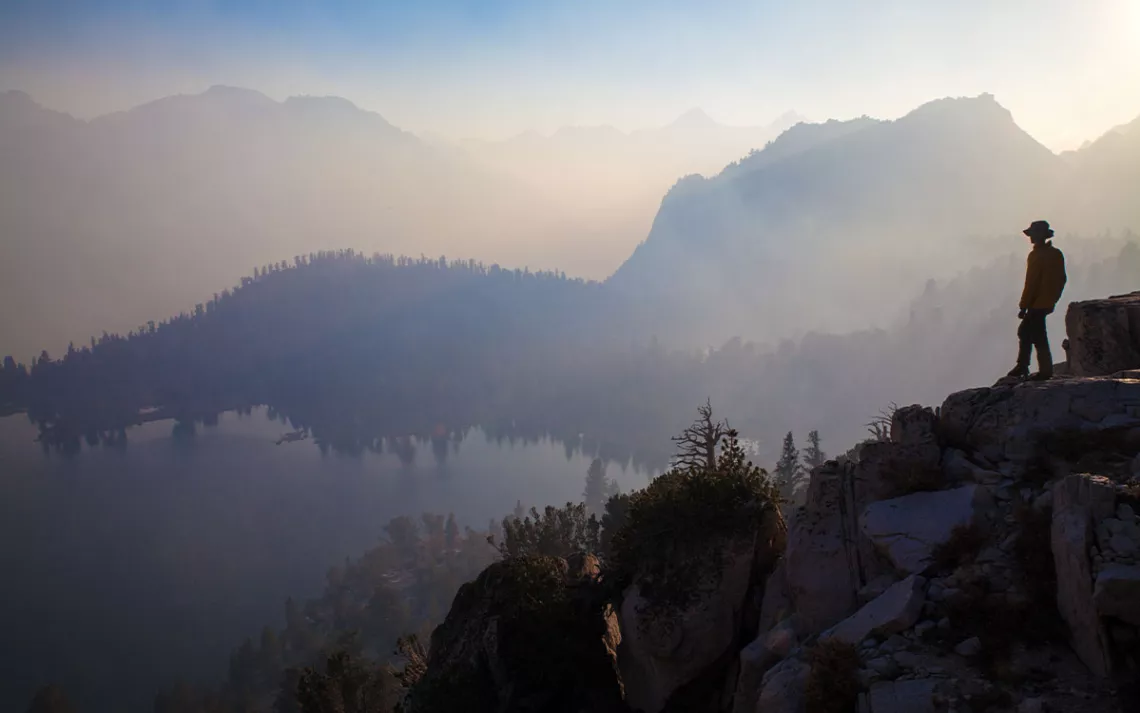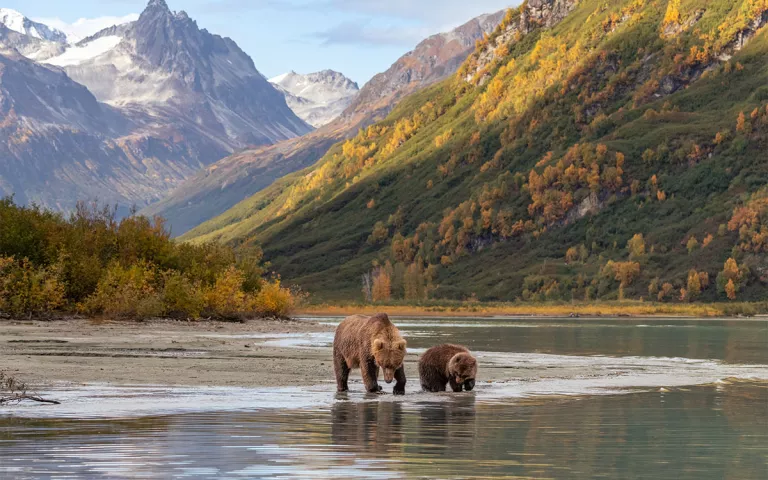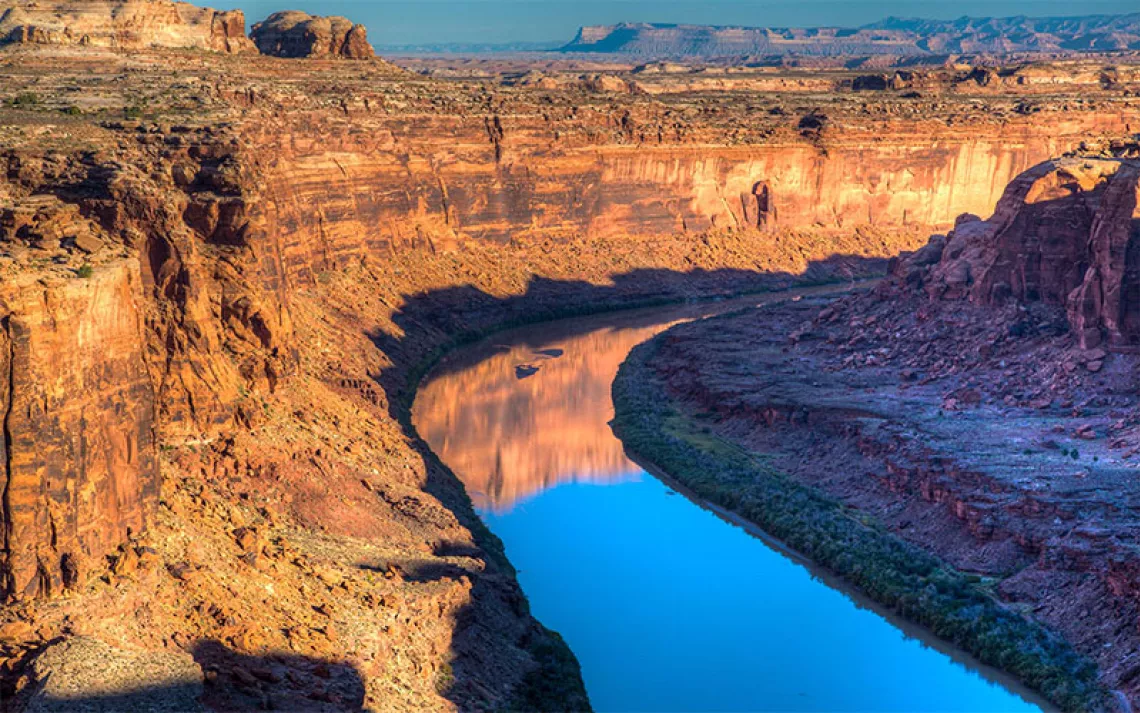In Praise of the Wilderness Act
On its 60th birthday, this landmark American conservation law is more valuable than ever

Charlotte Lake, Sierra Nevada, California. | Photo by Christina Felschen/Getty Images
Federal lawmaking is rarely celebrated for the quality of its prose, which tends to fall somewhere between bureaucratic pidgin and impenetrable lawyer-ese. The Wilderness Act is an inspiring exception. Signed into law by President Lyndon Johnson 60 years ago this coming week, the Wilderness Act exhibits a quiet poetry rarely found in legislation. The law defines wilderness as a place where, “in contrast with those areas where man and his works dominate the landscape … the earth and its community of life are untrammeled by man, where man himself is a visitor who does not remain.”
In the six decades since its passage, the Wilderness Act has far exceeded the original aspirations of its authors. There are today some 750 congressionally designated wilderness areas in the United States that, together, safeguard 111 million acres under the highest standard of protection. Wilderness areas include alpine basins where the roar of glacier rivers never cease, the driest stretches of red desert where water hardly ever ripples, along with swamps and prairies and seashores. These are places set beyond the reach of the chainsaw and the bulldozer. They are landscapes kept free from overt human designs and desires. That we Americans have succeeded in preserving some smidgen of the country from industrial civilization’s dominance is an accomplishment worth a 60th birthday bash.
There’s no question, though, that for all of the law's accomplishments, events have overtaken the best intentions of the visionaries who framed the law. The world has changed. Today there is no place that remains perfectly untouched by humanity’s long reach. Advanced telecommunication technologies make it harder than ever to locate unbroken solitude. (Though, come on, you can always leave the cellphone at the trailhead or just ignore the five bars of connectivity available on the mountain peak.) The high temperatures and weird weather delivered by climate change easily vault over the legal lines of a map. The ecosystem dislocations wrought by climate chaos—extreme wildfires, the migrations of exotic species—are forcing hard questions about whether to leave landscapes unmanaged.
The new realities of this hot, strange century have led some people to question whether wilderness truly exists. The critiques of wilderness range from plain old hating to good faith doubts to constructive reevaluation. Such criticism has been a long time coming. It’s been more than 30 years since the environmental historian and geographer William Cronon published an essay titled “The Trouble With Wilderness; or, Getting Back to the Wrong Nature.” In the decades since, Cronon’s critique has gone from heresy to orthodoxy, his essay a staple of environmental-studies reading lists. Today you’re more likely to encounter self-described environmentalists who say human interests must trump the needs of all other species than you are to find conservationists focused on protecting big landscapes. The backyard garden has replaced the remote wilderness as the most popular metaphor for how humans can and should relate to nonhuman nature.
But if you examine the wilderness ideal carefully—if you’re willing to take the time and make the physical effort to ground-truth wilderness with your own two feet—you’ll discover that the notion of preserving some places from direct human intervention continues to have real worth. For all of its blind spots and shortcomings and idiosyncrasies, the Wilderness Act remains as relevant as ever. If anything, the long reach of civilization makes the wilderness ideal even more valuable than when the act was written. On its 60th birthday, the Wilderness Act is important not despite the fact that we live on a garden planet—but because of it.
The most common critiques of the idea of wilderness go like this: By elevating one kind of nature—the remote, untamed landscape—and putting it on a pedestal, the wilderness ideal exacerbated the pernicious notion that we humans are apart from ecosystems. In doing so, it elided humans’ millennia-long role as ecosystem engineers. And, perhaps worst of all, the traditional conception of wilderness erased the history, and continued presence, of Indigenous peoples on the American landscape.
But as with any living thing, the ideal of wilderness has evolved in the last 60 years, and certainly in the 100 years since the first “primitive area” (the precursor to legal wilderness) was established by the US Forest Service in the piñon-juniper uplands of New Mexico’s Gila River area. In other words, the wilderness ideal has matured. As the physical world has changed—and as our understanding of ecological history has improved—so too has the way we think about wilderness, which has always been contingent on the times in which we live. It’s quite possible to celebrate wilderness without fetishizing it, to appreciate humans’ role on the landscape while still treasuring the untamed, and to embrace a self-aware romanticism for leaving some places untrammeled.
You can see this evolution—this maturation—in the passion for rewilding. If 20th-century conservation was about drawing lines on a map to keep human damage at bay, 21st-century conservation is increasingly about filling in those lines via virtuous human interventions. The reintroduction of the gray wolf is a classic example. So is the Native-led recovery of the bison. The intensely managed, hugely expensive, and decades-long effort to return the California condor to the skies of the American West is another rewilding success story. Rewilding offers an example of how, sometimes and in some places, we shouldn’t strive to “leave no trace” but rather to leave a landscape better than we found it.
At the same time, there is now a widespread appreciation among environmentalists of Indigenous nations’ ancient history on the land and how, for time immemorial, they shaped the contours of the continent Europeans stumbled upon. One example of this is the land management agencies’ new embrace of Indigenous fire practices. In some places—Bears Ears National Monument in Utah is a prime example—the federal government has entered into historic comanagement agreements with local tribes. Another way of acknowledging the Indigenous presence on the land is by simply changing place-names. The highest peak in the Black Elk Wilderness of the South Dakota Black Hills used to be called Harney Peak, named for a notorious Indian-killer named William Harney. In 2016, the US Board of Geographic Names changed it to Black Elk Peak in honor of the Lakota spiritual leader.
Even as the conservation movement moves toward a more open-eyed conception of wilderness, it may be that some elements of modern wilderness once perceived as weaknesses may now be considered virtues. Take the idea of remoteness. It’s true that wilderness areas, as places distant and apart from our daily lives, can’t instruct us in how precisely to live in balance with nonhuman nature in the way a garden might. But as a gardener and an erstwhile organic farmer, I think that wilderness in the 21st century provides something just as important: It can give us the inspiration to attempt such an effort in the first place.

A mother brown bear teaching her cub to fish at secluded Crescent Lake, in the middle of one of the most remote US national parks: Lake Craig. | Photo by Teresa Kopec/Getty Images
Many of our legal wilderness areas—whether high-country landscapes of rock and ice or searing deserts—are inhospitable. They are not places where it would be easy to survive or thrive for very long. They are not our home; we are, truly, visitors who “do not remain.” That’s the point. These are landscapes that, above all, provide homes to other creatures. The wilderness’s indifference and inhospitableness are a reminder that, even as it's an almost totally humanized planet, Earth doesn’t belong to us. Sigurd Olson, a onetime president of the Wilderness Society, made this point decades ago when he wrote, “The very presence of wilderness is a balance wheel to civilization, a reminder of the basic problems of existence.”
To encounter such places is to receive a jolt of perspective. An ancient rock face can be a portal to deep time that encourages us to consider how brief our time on this planet is—and in the process might force a reconsideration of our obligations to future generations. The long miles of the trail undertaken at the pace of hoof or foot (no wheels allowed in the wilderness) can make us rethink scale. Among the most common observations people make when confronted with wild nature is that the landscape makes them feel small. Another way of describing this sensation would be to say that in the wild, we are right-sized. The wild puts us in our place, a spot somewhere beneath the pinnacle of all existence.
The wilderness decenters people, and that in itself is invaluable. Wilderness puts humans—if only for a visit and only in some places—at the periphery of the story of life. Big, wild lands shatter our species solipsism. They compel us to recognize that other species have their own distinct interests that are every bit as equal to and intrinsic as ours.
The best way to earn such lessons is to drive to wherever the roads end and make your way forward on muscle power alone. But as the novelist and conservationist Wallace Stegner wrote in his now-canonical “wilderness letter,” we all benefit from the presence of wilderness even if we have never been present within it. “The reminder and the reassurance that it is still there is good for our spiritual health even if we never once in ten years set foot in it. . . . We simply need that wild country available to us, even if we never do more than drive to its edge and look in.”
Truly, though, the greatest benefits of wilderness are not what it delivers to people but what it delivers to other life-forms. Wilderness is a gift to the rest of life on Earth, offered in the form of forbearance and restraint. For rivers, a chance to flow unimpeded. For trees, a chance to grow without the threat of being cut down. For bears and wolves and mountain lions, room to roam. For the songbirds, a place to sing their little hearts out, undistracted by the racket of civilization.
To make a gift to another can bring joy to the giver as much as to the recipient. So it is with wilderness. Even if these gifts aren’t for us, we also benefit from the offering. The wilderness can, as Aldo Leopold wrote of his land ethic, “enlarge the boundaries of the community to include soils, waters, plants, and animals.” It can expand our moral vision.
In the wilderness, I’ve often found, it seems like you can see farther. There are vistas upon vistas, mountains beyond mountains. What’s there on the horizon? More lands, waters, and wildlife that still need protection. Thanks to the Wilderness Act, we Americans have a powerful tool at hand to offer such protection—for another 60 years to come, and for generations beyond.
 The Magazine of The Sierra Club
The Magazine of The Sierra Club



